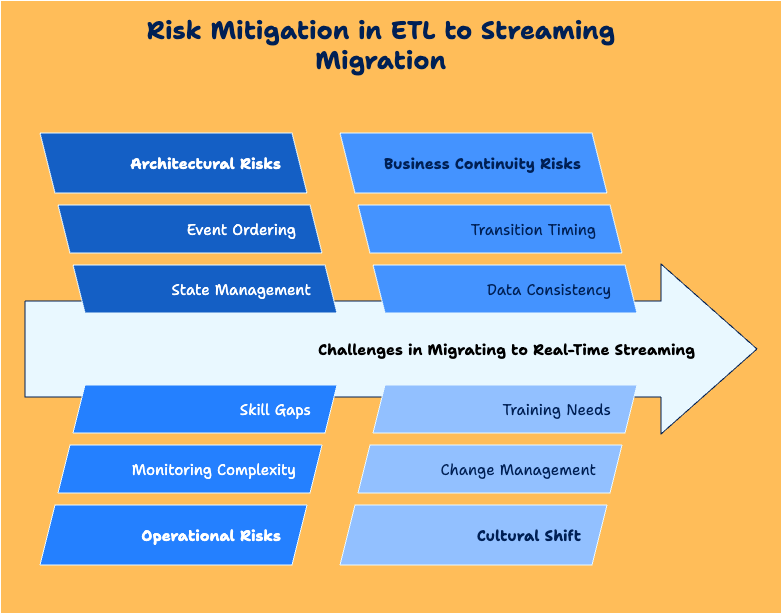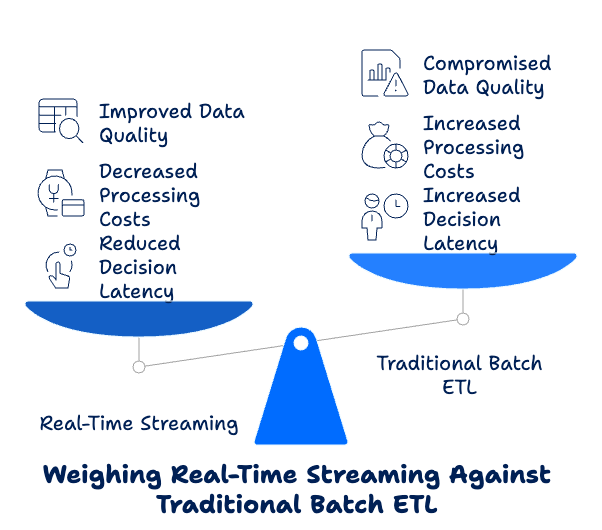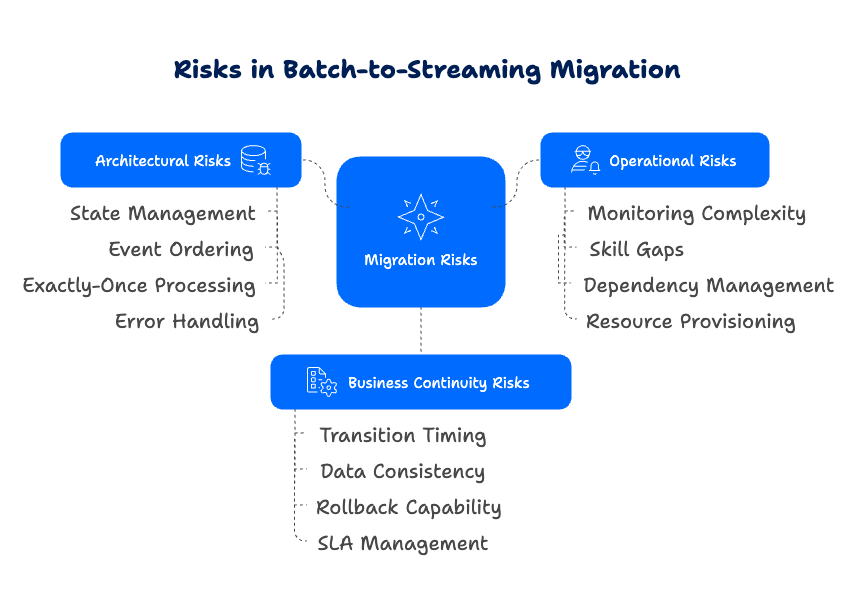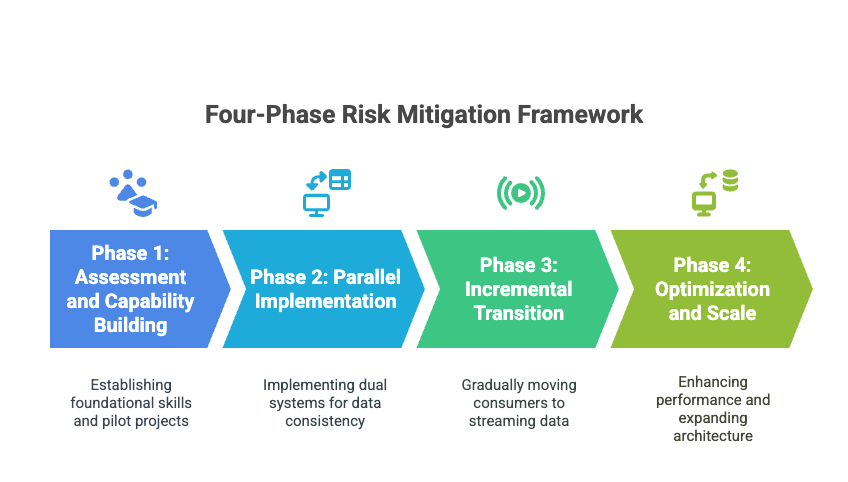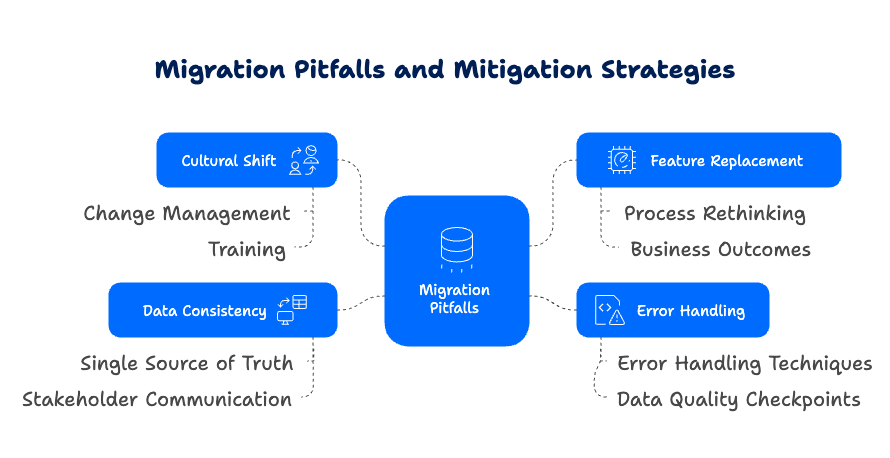#013 - From Batch ETL to Real-Time: A 4-Step Risk Mitigation Framework for Data Leaders
Don't Let Your Real-Time Data Project Fail Silently. Learn the Key to Successful ETL Streaming Migration.
Hey there,
Welcome to this week's edition, where we tackle one of the most challenging transitions in modern data architecture: migrating from batch ETL to real-time streaming.
Introduction
In today’s fast-paced business world, traditional batch ETL processes often lead to data delays and resource spikes, hindering agility. While moving to streaming offers real-time responsiveness, it also presents hidden challenges. Embracing this shift can elevate your data strategy and empower your organization like never before!
Here is what we are going to discuss today:
The fundamental architectural differences between batch and streaming
Three major risk categories you must address for successful migration
A practical four-phase framework for risk mitigation during transition
Let’s dive in.
The Fundamental Architectural Shift
Quick Summary: Batch ETL works with defined data sets, while streaming ETL tackles an endless flow of data in real time.
Transitioning from batch ETL to streaming ETL is an exciting opportunity for your organization to enhance its data management! Recognizing these differences is vital for a smooth and successful shift.
Batch ETL deals with specific datasets that have defined start and end points, processing data at regular intervals. However, issues with data quality can sometimes disrupt these batches.
On the other hand, streaming architectures handle real-time data seamlessly! They require continuous resource allocation and process each record as it arrives, presenting unique challenges in error management.
This transition influences infrastructure and monitoring and calls for fresh approaches to data processing. Embracing this innovative shift is crucial for unlocking new possibilities and driving successful outcomes!
The Business Case for Real-Time Streaming
Before diving into implementation, let's clarify why organizations are making this shift. Real-time streaming offers several compelling advantages over traditional batch ETL:
Reduced decision latency: Insights are available in seconds instead of hours or days
Decreased processing costs: Smaller, continuous workloads instead of resource-intensive batch jobs
Improved data quality: Issues are identified and addressed at the source rather than discovered during batch failures
Enhanced business agility: Ability to respond to events as they happen, not after the fact
Architectural simplification: Eventually eliminates complex scheduling dependencies
However, these benefits come with significant implementation challenges that must be addressed through a structured migration approach.
The Three Major Risk Categories
Successful batch-to-streaming migrations must address three primary risk categories:
1. Architectural Risks
Batch and streaming architectures follow fundamentally different paradigms. Batch processing is designed around static datasets with clear beginnings and endings, while streaming deals with unbounded, continuous data flows. This paradigm shift creates several architectural challenges:
State management: Streaming systems must maintain state across processing windows
Event ordering: Ensuring proper sequencing when messages arrive out of order
Exactly-once processing: Preventing duplicate processing while ensuring no events are missed
Error handling: Managing failures without stopping the entire pipeline
2. Operational Risks
The operational model for real-time systems differs significantly from batch operations:
Monitoring complexity: Continuous processes require different monitoring approaches
Skill gaps: Teams need new skills to support streaming architectures
Dependency management: Upstream and downstream systems may not be ready for real-time
Resource provisioning: Consistent performance requires different resource allocation strategies
3. Business Continuity Risks
Perhaps most critically, maintaining business continuity during migration is essential:
Transition timing: Determining when to switch from batch to streaming
Data consistency: Ensuring data integrity across both systems during transition
Rollback capability: Maintaining the ability to revert if issues arise
SLA management: Meeting existing service level agreements during migration
A Four-Phase Risk Mitigation Framework
To address these risks systematically, I recommend a four-phase approach that has proven successful across multiple enterprise migrations:
Phase 1: Assessment and Capability Building
Key Activities:
Catalog existing batch ETL processes and their business criticality
Identify data flows most suitable for initial streaming implementation
Assess team skills and develop training plans
Establish success metrics for the migration
Risk Mitigation Techniques:
Conduct a pilot on non-critical data flows: Start with lower-risk data streams to build expertise
Build a streaming competency center: Develop internal expertise before widespread adoption
Implement streaming design patterns training: Ensure teams understand fundamental streaming concepts
Deploy sandbox environments: Provide safe spaces for teams to experiment with streaming technologies
This preparation phase is often rushed or skipped entirely, but it's essential for setting the foundation for success. Industry research consistently shows that organizations that invest in proper capability building before implementation avoid significant rework and project delays later in the migration journey.
Phase 2: Parallel Implementation
Key Activities:
Design streaming pipelines alongside existing batch processes
Implement real-time data capture mechanisms at sources
Develop reconciliation frameworks to compare batch and streaming outputs
Create fallback mechanisms to batch processing
Risk Mitigation Techniques:
Implement change data capture (CDC): Use CDC patterns to capture source changes without modifying existing systems
Develop dual-write mechanisms: Write to both systems during transition to enable comparison
Establish automated reconciliation: Build an automated comparison between batch and streaming outputs
Create circuit breakers: Design automatic fallbacks to batch processing when streaming issues occur
This parallel approach provides safety nets that maintain business continuity. Studies of successful streaming implementations show that this method consistently helps teams identify edge cases and boundary conditions that wouldn't have been apparent until they caused production issues.
Phase 3: Incremental Transition
Key Activities:
Gradually migrate consumers from batch to streaming outputs
Implement monitoring specific to streaming processes
Adapt data governance practices to real-time paradigm
Establish performance baselines and optimization targets
Risk Mitigation Techniques:
Implement feature flags: Allow granular control over which data elements use streaming
Create shadow consumers: Test streaming consumption without impacting production systems
Deploy comprehensive monitoring: Monitor latency, throughput, and error rates with alerting
Establish recovery mechanisms: Create procedures for point-in-time recovery if issues occur
The incremental approach allows you to build confidence while limiting exposure. According to case studies from successful migrations, this strategy works effectively when teams transition one data element at a time, allowing them to roll back specific components quickly without disrupting the entire system.
Phase 4: Optimization and Scale
Key Activities:
Optimize streaming pipelines for performance and cost efficiency
Decommission redundant batch processes
Expand streaming architecture to additional data domains
Implement advanced streaming patterns (e.g., stateful processing, complex event processing)
Risk Mitigation Techniques:
Implement performance benchmarking: Continuously measure against established baselines
Maintain batch capability selectively: Keep batch capabilities for disaster recovery
Deploy chaos engineering practices: Proactively test failure scenarios
Establish streaming governance: Develop standards and best practices for future implementations
Even in this phase, maintain the ability to revert to batch for disaster recovery. Research on enterprise streaming implementations indicates that regular "resilience testing" helps organizations identify potential failure points before they impact production systems.
Common Pitfalls and How to Avoid Them
Research on streaming migration projects has identified several recurring challenges that organizations frequently encounter:
Pitfall 1: Underestimating the Cultural Shift
Streaming requires a fundamentally different mental model for data processing. Studies show that organizations focusing exclusively on technology without addressing the cultural shift often struggle with adoption.
Mitigation Strategy: Invest in change management and training focusing on real-time thinking. Develop new operational playbooks that reflect the continuous nature of streaming systems.
Pitfall 2: Direct Feature-for-Feature Replacement
Attempting to replicate existing batch processing features exactly in streaming often leads to overcomplicated solutions.
Mitigation Strategy: Rethink processes from first principles rather than directly translating batch logic. Ask, "What business outcome are we trying to achieve?" rather than, "How do we do this same process in streaming?"
Pitfall 3: Inadequate Error Handling
In batch systems, errors often cause the entire job to fail, making them visible. In streaming, errors can be more subtle, affecting only certain events or creating silent data quality issues.
Mitigation Strategy: Implement comprehensive error handling with dead letter queues, detailed logging, and automated alerting. Create data quality checkpoints that verify critical business rules are maintained.
Pitfall 4: Neglecting Data Consistency During Transition
During parallel operation, data inconsistencies between batch and streaming outputs can erode business confidence in the migration. Research indicates this is a primary reason why streaming projects stall before completion.
Mitigation Strategy: Implement a "single source of truth" approach where either batch or streaming is authoritative during transition. Clearly communicate to stakeholders which system is definitive and which data elements are needed.
Conclusion
Migrating from batch ETL to real-time streaming is a transformative journey beyond technology. Organizations can navigate this complex transition by applying a structured risk mitigation framework while maintaining business continuity.
The most successful migrations share common characteristics: they build capabilities before attempting full implementation, use parallel processing to validate outcomes, transition incrementally, and optimize continuously as they scale. By following these principles, organizations can unlock the full potential of real-time data while minimizing the inherent risks of such a fundamental architectural shift.
Remember that this migration is a technical project and a strategic business transformation. Organizations that approach it with appropriate risk management will gain significant competitive advantages through enhanced agility, reduced costs, and the ability to deliver insights when they create maximum value—in real time.
That’s it for this week. If you found this helpful, leave a comment to let me know. ✊
About the Author
With 15+ years of experience implementing data integration solutions across financial services, telecommunications, retail, and government sectors, I've helped dozens of organizations implement robust ETL processing. My approach emphasizes pragmatic implementations that deliver business value while effectively managing risk.


